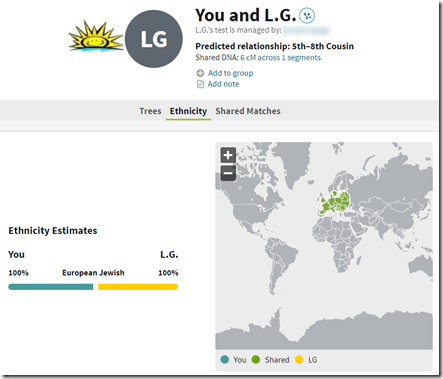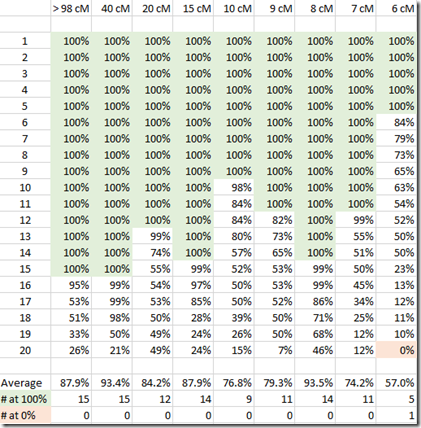Have you heard the big hubbub going on in genetic genealogy circles? Ancestry will be dropping your 6 and 7 cM matches from your match list.
In my case, I have 192,306 DNA matches at Ancestry. Of those, 54,498 matches are below 8 cM meaning Ancestry will drop over 28% of the the people on my match list.
The Proof Corner
Many of the DNA experts understand that a 6 or 7 cM segment is small and is rarely useful for proof of anything. That is totally true. As Blaine Bettinger states, small segment are “poison”. They are often false matches. When they are not, those segments are usually too many generations back to be used as “proof” of the connection.
I am not talking about Y-DNA or mtDNA here. Those have provable qualities in them. I’m talking about autosomal matching, you know, the DNA where the amount of DNA you share with a cousin reduces with each generation and you can be a 3rd cousin with someone and not share anything.
The only reasonable way to use autosomal segment matches as a “proof” is to use the techniques Jim Bartlett developed for Walking an Ancestor Back. This technique uses combinations of MRCAs on the same ancestral line, e.g. a 2C, a 3C, a 5C and a 7C all matching on the same segment who are on the same line. Jim has been able to do this successfully only because he has an extensive family tree and has rigorously mapped all his matches into triangulation groups over his whole genome. This is something that 99.9% of us will never attempt.
Note that Jim only includes matches that triangulate that are at least 7 cM. He is also aware that small segments may be false even when triangulated, so he excludes them.
But too often, people find through a DNA match a new 7th cousin, and find a family tree connection to them, and then claim that the DNA match proves the connection. This is so untrue on so many fronts.
Or people find two relatives who have a segment match that starts and/or ends at the same position as another DNA match. They then use this as proof of their connection to Charlemagne. Now doesn’t that sound ridiculous?
The Hint Corner
So why the worry of eliminating these mostly false, poison matches that can’t prove anything from your Ancestry DNA match list? It’s because they are hints.
As genealogists, we are using our DNA matches to find possible relatives that have common ancestors with us. We do that to extend our tree outwards and up. Any person who may have researched a part of our tree and have information about our relatives and ancestors that we don’t have is a very welcome find. (Hopefully they’ll respond to our email!)
So of my 192,306 matches, the closest 1% are the best candidates for me to research and see if I can connect them.
What about the other 99%? Surely, some of them might turn up to be a closer cousin than expected, or be along a line that I have researched deeper.
Obviously, none of us can spend the rest of our lives researching 190,000 matches one by one. So what do we do. We filter them to get interesting candidates, via:
1. A match who shares a common ancestor.
2. Match name who matches a surname in our tree
3. Surname in matches’ tree who matches one of ours
4. Birth location in matches’ tree that is a place our ancestors were from, or our relatives now live.
5. Shared matches who match with some of our DNA matches who we already have in our tree.
6. ThruLines, which compares the trees of our DNA matches for us and gives us possible family connections that we can investigate.
The people we find through any of these 6 methods (and other similar methods) is a way to take an unmanageable list of 192,000 people and select a subset for us to look at. Our hope (we don’t know this for sure) is that this will include more people who we’ll be able to connect to our family, and exclude the ones who are less likely.
So what most people are lamenting is not the loss of 28% of their DNA matches, but a loss of 28% of the hints they might be able to use.
Recommendation
If you want, there are ways to save some of the 6 and 7 cM matches that Ancestry will soon be eliminating. I won’t describe them here since many others already have. See Randy Seaver’s summary.
But please, don’t spend the next few weeks robotically marking the tens of thousands of small matches so that you don’t lose them. Yes, maybe one of them will turn out to be a hint one day. But you’ve got all your other matches to work with as well. You won’t run out of things to do, I guarantee it.
Addendum: July 29, 2020:
If small DNA matches of 6 or 7 cM at Ancestry DNA cannot be used to prove a connection, because they are either false matches, or are too many generations back to confirm their ancestral path, then why can they be used as hints?
Answer: Simply because if you take a random selection of, say, 20,000 DNA testers at Ancestry, some of them will be relatives of yours. They may not actually share DNA with you, since 3rd cousins and further need not, but they could be people whose family tree connects to yours.
Basically, Ancestry DNA is giving you hints by simply giving you a large random selection of DNA testers. Their filtering tools (surname, place) may narrow those down to possible relatives, who don’t necessarily share any actual DNA with you.
But these hints are better than just random hints. They will likely be people who share more ethnicity with you than a random DNA tester at Ancestry would.
For example, Ancestry has me at 100% European Jewish. If I compare myself with my first 6 cM match at Ancestry, I get this:
This 6 cM match of mine also has 100% European Jewish ethnicity.
To see if this was generally the case, I took my closest 20 matches, and my first 20 matches at 40 cM, at 20 cM, 15 cM, 10 cM, 9 cM, 8 cM, 7 cM and 6 cM. I marked down what percentage of European Jewish they had. Then I sorted each group of 20 highest to lowest. I get this:
Of the 180 matches I checked 179 had some European Jewish Ancestry. Over half of the matches also had 100% European Jewish ethnicity and many of them have 50% or more.
There is a much greater chance that I might find a connection to someone with European Jewish ancestry than someone without any, so these are good hints. Using ancestral surname and place filtering tools, I might find that some of these people are relatives and they can help me extend my family tree.
Does that mean that we share DNA? Not necessarily. The matches, especially the small ones, may be false matches.,
Or we may actually share DNA. but the segments we share may not be coming from the common ancestor we found, but may be from another more distant line that we’ll never find, or it may be (especially in my case) general background noise from distant ancestors due to endogamy. We don’t know and cannot tell.
None-the-less, these matches are hints that might connect you to a relative.




